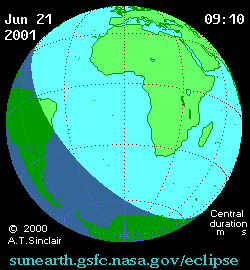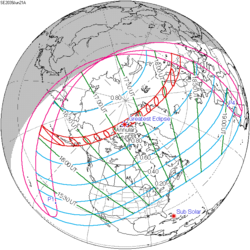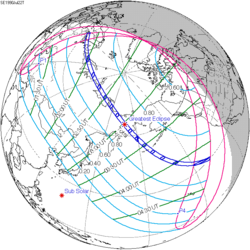| Total eclipse | |
 Totality from Lusaka, Zambia by the Williams College eclipse expedition | |
| Gamma | −0.5701 |
|---|---|
| Magnitude | 1.0495 |
| Maximum eclipse | |
| Duration | 297 s (4 min 57 s) |
| Coordinates | 11°18′S2°42′E / 11.3°S 2.7°E |
| Max. width of band | 200 km (120 mi) |
| Times (UTC) | |
| (P1) Partial begin | 9:33:04 |
| (U1) Total begin | 10:35:59 |
| Greatest eclipse | 12:04:46 |
| (U4) Total end | 13:31:37 |
| (P4) Partial end | 14:35:25 |
| References | |
| Saros | 127 (57 of 82) |
| Catalog # (SE5000) | 9511 |
A total solar eclipse occurred at the Moon's ascending node of orbit on Thursday, June 21, 2001, [1] with a magnitude of 1.0495. It was the first solar eclipse of the 21st century. A solar eclipse occurs when the Moon passes between Earth and the Sun, thereby totally or partly obscuring the image of the Sun for a viewer on Earth. A total solar eclipse occurs when the Moon's apparent diameter is larger than the Sun's, blocking all direct sunlight, turning day into darkness. Totality occurs in a narrow path across Earth's surface, with the partial solar eclipse visible over a surrounding region thousands of kilometres wide. Occurring about 2.25 days before perigee (on June 23, 2001, at 18:20 UTC), the Moon's apparent diameter was larger. [2]
Contents
- Visibility
- Observations
- Coincidence
- Eclipse timing
- Places experiencing total eclipse
- Places experiencing partial eclipse
- Eclipse details
- Eclipse season
- Related eclipses
- Eclipses in 2001
- Metonic
- Tzolkinex
- Half-Saros
- Tritos
- Solar Saros 127
- Inex
- Triad
- Solar eclipses of 2000–2003
- Saros 127
- Metonic series
- Tritos series
- Inex series
- Notes
- References
Many people traveled to Africa to watch the eclipse; [3] [4] [5] the Daily Telegraph reported that "while some tribesmen watch a celestial crocodile eating the sun, the modern African will be counting the cash brought in by thousands of visitors". [6]












































































































